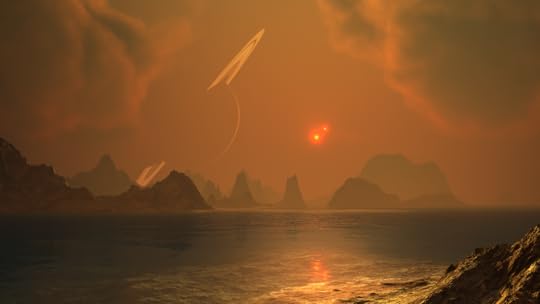What makes Saturn’s largest moon Titan interesting?

Isn’t that a wonderful sight? Gave me the goose-bumps when I first came across images from this strange world in our very own friendly neighborhood. Well, technically it is still a billion miles from Earth but considering the vast distances quite common in the Universe, a billion miles looks like next door.
When I first saw these beautiful images and artworks on Titan, I decided to make this hazy orange moon as the setting for my debut novel Starship Samudram. I researched extensively on the specialty of Titan and found these fascinating facts:
Titan is the largest moon of the second largest gas-giant (i.e. Saturn) in our Solar System.
The temperature on Titan is 270 points below 0. That would be devilishly cold, I suppose.
Methane, the gas that is usually found in marshlands on Earth, exists on Titan in liquid form.
There is a methane-cycle on Titan similar to the water-cycle on Titan. Yes, you are right! Methane actually rains on this strange world, flows in streams, and pretty much does what water does on Earth. In that sense, scientists have often found Titan quite similar to Earth.
Owing to this methane-cycle, there are vast lakes of liquid methane on Titan’s surface. One of the prominent lakes Ligeia Mare has a surface area of 126,000 square kilometers and a shoreline that extends to 2000 kilometers.
Saturn looms in Titan’s skies, much larger than the sun in our skies on Earth and probably resulting in some breathtaking views. Imagine a penthouse overlooking Ligeia Mare with Saturn rising on horizon. Oh the possibilities!
Titan is locked in a geo-synchronous orbit around Saturn. Meaning that the same side will always be facing Saturn. That’s why those awe-inspiring sights!
The gravity on Titan is 1/7th of Earth. So, you can probably fly on Titan if you jump from a mountain. That is, until you fall in some hydrocarbon infested lake and drown because of lake of density.
One of my primary goals while writing Starship Samudram was to speculate on how it might be for the first human explorers to arrive on Titan. What will they see and feel? What kind of obstacles they might face—natural and psychological? Of course, all of this with a seasoning of fiction and mystery.
I am sure there are many more mysteries about Titan, something which I hope to explore in the sequel to Starship Samudram. But, what do you think about this amazing world in the comments section below? Should mankind even try to visit it?
If you want to read my take about Titan’s eco-system, get your copy of Starship Samudram today.



